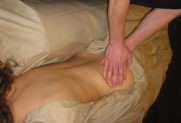
Coccyx Massage
Coccyx pain is a relatively common problem which can be range from mildly annoying to quite debilitating for some people. Often it is the result of an impact or fall directly onto the coccyx which can have happened a long time previously. The impact caused structural damage or dysfunctional alignment to the coccyx which may not necessarily lead to pain at the time but only manifest years later.
There is some dispute whether a normal coccyx should have some ability to gently curve and flex or whether it should be fixed. Coccyx pain is normally the result of the following:
1. Coccyx is angled forward sharper (as a result of impact)
2. Coccyx is side-bent to one side more than the other or
3. The coccyx has no ability to flex at all.
Massage to the coccygeal area can be beneficial when carried out by a suitably trained therapist. Most of the bodywork will consist of myofascial release in the area coupled with gentle mobilisation. Erik Dalton uses the following technique for coccyx release:
Therapist releases tight right pelvic ligaments by reaching across the body and contacting the left ischial tuberosity with his dominant thumb and sliding up and under attachments at the inferior border of the sacrum. The therapist’s other thumb braces on top, maintaining sustained “scooping” pressure to release ligaments and gently lift the coccyx from its hooked position.
Please note that coccyx massage is considered to be specialised and if you are interested in ever making a booking specifically to address coccygeal pain then make sure that you ask whether a therapist has received specific coccyx massage training. I have received some training (although would not consider myself a specialist at coccyx massage).
Please feel free to contact me on 0434631987 if you have any questions and check out my guarantee so that any coccyx massage/bodywork I provide is not what you were expecting or hoping for then there is no charge.
Coccyx is “Seat of soul” – problems such as nausea, bed wetting, PMS may be associated with a hooked coccyx. Bones supposed to flex when sit down but not supposed to stay there. Rolf had students go in either side and work sacrotuberus ligament out and “hope for the best”.
Dalton prefers to work one side if coccyx is side-bent to one side (dura mata pull?). Move coccyx back to where it belongs by releasing pubbococcygeal muscle. If it is tender then there is a problem in the area.
Childbirth can cause problem with coccyx.
Hooked coccyx often associated with shift to left (ED no idea why).
2.10 Routine for coccyx (and pelvic floor dysfunction). Come across and off coccyx and feel for sacrotuberous ligament. Lift the tissue up. Assess for side-bend (“more room” one side than the other).
3.45 Sacrococcygeal ligaments. Get client to pelvic tilt and then attempt to move the coccyx. Push sacrum up and work coccyx. Move sacrum around after you come out to reset.
Good for PMS symptoms that aren’t going away.